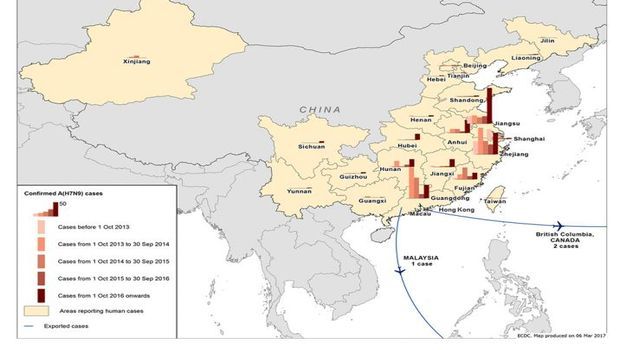Highly Pathogenic A(H7N9) Virus Mutation Does Not Change Risk to Humans
In February 2017, a new A(H7N9) virus -- indicating high pathogenicity in poultry -- was detected in three patients connected to Guangdong, China, as well as in environmental and poultry samples. This is an important development to be monitored, however, European Centre for Disease Prevention and Control (ECDC)'s updated rapid risk assessment concluded that the risk of the disease spreading within Europe via humans is still considered low, as there is no evidence of sustained human-to-human transmission. Although the genetic changes in A(H7N9) may have implications for poultry, to date, there is no evidence of increased transmissibility to humans or sustainable human-to-human transmission.


This is figure 1, confirmed cases, from ECDC updated rapid risk assessment, March 9, 2017. Courtesy of ECDC
In February 2017, a new A(H7N9) virus -- indicating high pathogenicity in poultry -- was detected in three patients connected to Guangdong, China, as well as in environmental and poultry samples. This is an important development to be monitored, however, European Centre for Disease Prevention and Control (ECDC)'s updated rapid risk assessment concluded that the risk of the disease spreading within Europe via humans is still considered low, as there is no evidence of sustained human-to-human transmission. Although the genetic changes in A(H7N9) may have implications for poultry, to date, there is no evidence of increased transmissibility to humans or sustainable human-to-human transmission.
Since the notification of a novel reassortant influenza A(H7N9) virus on 31 March 2013, 1,258 laboratory confirmed cases of human infection with avian influenza A(H7N9) virus have been reported. This is the fifth winter season in the northern hemisphere with human cases caused by A(H7N9) infections. During this wave, the number of human cases has been higher than in previous waves and accounts for 37 percent of the human cases reported so far. This is most likely due to greater environmental contamination in live bird markets and increased circulation of the virus among poultry.
In February 2017, a new A(H7N9) virus with mutations in the haemagglutinin gene -- indicating high pathogenicity in poultry -- was detected in two patients from Guangdong and one patient from Taiwan with a travel history to Guangdong, as well as in environmental and poultry samples. However, this new virus has been detected in only three out of 460 human cases confirmed in the current epidemic wave and in one province only. It is unclear at the moment if the newly-emerged, highly-pathogenic avian influenza (HPAI) virus A(H7N9) will replace the low pathogenic virus or if both will co-circulate in the bird population.
Evidence presented at the recent WHO influenza vaccine composition meeting showed both the newly emerged and some of the currently circulating A(H7N9) viruses to be genetically and antigenically distinct from current A(H7N9) candidate vaccine viruses. To address this, new A(H7N9) candidate vaccine viruses were proposed. In addition, the HPAI A(H7N9) strain in these three patients presented with a mutation in the neuraminidase (NA) gene associated with reduced susceptibility to neuraminidase inhibitors. Mutations related to resistance to neuraminidase inhibitors have possibly emerged during the antiviral treatment of the three patients.
The continued transmission of A(H7N9) to humans in China poses the risk that sporadic imported cases may be detected in Europe. The following options for prevention and control of the infection should be considered:
•people traveling to China should avoid direct exposure to poultry and refrain from visiting live poultry markets or backyard farms;
•travelers who have visited affected areas and develop respiratory symptoms and fever upon their return should consult a physician and mention their recent travel history to enable early diagnosis and treatment.
The possibility of humans infected with A(H7N9) returning to the EU/EEA cannot be excluded.
Read the rapid risk assessment: Genetic evolution of influenza A(H7N9) virus in China - implications for public health/.
Source: European Centre for Disease Prevention and Control (ECDC)
Top 7 Infection Control Today Articles of 2024: Insights and Innovations
December 30th 2024From advanced sterilization methods to combating antimicrobial resistance, Infection Control Today’s top articles of 2024 delivered actionable strategies for safer healthcare environments and improved patient outcomes.
Revolutionizing Infection Prevention: How Fewer Hand Hygiene Observations Can Boost Patient Safety
December 23rd 2024Discover how reducing hand hygiene observations from 200 to 50 per unit monthly can optimize infection preventionists' time, enhance safety culture, and improve patient outcomes.
Redefining Competency: A Comprehensive Framework for Infection Preventionists
December 19th 2024Explore APIC’s groundbreaking framework for defining and documenting infection preventionist competency. Christine Zirges, DNP, ACNS-BC, CIC, FAPIC, shares insights on advancing professional growth, improving patient safety, and navigating regulatory challenges.
Addressing Post-COVID Challenges: The Urgent Need for Enhanced Hospital Reporting Metrics
December 18th 2024Explore why CMS must expand COVID-19, influenza, and RSV reporting to include hospital-onset infections, health care worker cases, and ER trends, driving proactive prevention and patient safety.